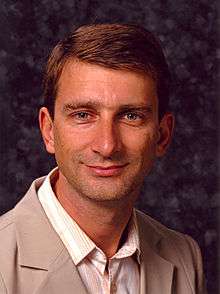Uroš Seljak
Uroš Seljak (born May 13, 1966 in Nova Gorica) is a Slovenian cosmologist, a professor of astronomy and physics at University of California, Berkeley.[1] He is particularly known for his research in cosmology and approximate Bayesian statistical methods.
Uroš Seljak | |
|---|---|
 Uroš Seljak in 2011 | |
| Born | 13 May 1966 |
| Citizenship | Slovenian, United States |
| Alma mater | University of Ljubljana, Slovenia (1989, 1991) and MIT (1995) |
| Occupation | Professor in Physics and Astronomy Departments, UC Berkeley and Senior Faculty Scientist, LBNL Berkeley |
| Known for | E and B-modes, CMBFAST |
| Academic work | |
|---|---|
| Research Areas | Cosmology
Theoretical and observational astrophysics Statistical data analysis in astrophysics Bayesian statistical methodology Machine learning |
| Doctoral advisor | Edmund Bertschinger |
| Awards | Member, National Academy of Sciences (2019)
American Physical Society Fellow (2013) Alfred P. Sloan Fellow (2001) Helen B. Warner award of American Astronomical Society (2001)[1][2] David and Lucille Packard Fellow (2000) Highest cited Slovenian scientist (2019) International Science Photography competition winner (2019) [3] |
Biography
After finishing the Nova Gorica Grammar School, Seljak did his undergraduate studies at the University of Ljubljana, Slovenia, graduating in 1989, and received a master's degree from the same institution in 1991. He then went to the Massachusetts Institute of Technology, receiving his Ph.D. in 1995.
After postdoctoral studies at the Harvard-Smithsonian Center for Astrophysics, he took faculty positions at Princeton University, the International Centre for Theoretical Physics in Trieste, Italy, and the University of Zurich, before joining the UC Berkeley physics and astronomy departments in 2008. He also holds a joint appointment with the Lawrence Berkeley National Laboratory.[1]
Work
Seljak is a cosmologist who is particularly known for his research on cosmic microwave background radiation[4],[5] galaxy clustering and weak gravitational lensing,[6] and the implications of these observations for the large scale structure of the universe.[7]
In 1997 Seljak predicted existence of B-modes in CMB polarization as a tracer of primordial gravitational waves from inflation [8]. Together with M. Zaldarriaga he developed CMBFAST code for CMB Temperature, E and B-mode polarization and for gravitational lensing effects on CMB[4].
In 2000 he developed the halo model for dark matter[9][10] and galaxy clustering statistics.[11]
Much of Seljak's recent work has been focused on how to extract fundamental properties of our universe from cosmological observations using analytical methods and numerical simulations. He has developed cosmological generative models of dark matter, stars and cosmic gas distributions, including differentiable FastPM code and its extensions.
Seljak is actively developing methods for accelerated approximate Bayesian methodologies, and applying them to cosmology, astronomy, and other sciences. Examples of this work are expectation optimization of L2 f-divergence for stochastic variational Bayes inference, Gaussianized bridge sampling for Bayesian evidence, and BayesFast, a surrogate model based Hamiltonian Monte Carlo sampler.
Seljak is developing machine learning methods with applications to cosmology, astronomy, and other sciences. Examples are Fourier based Gaussian process for analysis of time and/or spatially ordered data, generative models with explicit physics symmetries (translation, rotation), and sliced iterative transport methods for density estimation and sampling.
Former Doctoral Students
- Matias Zaldarriaga (co-advisor)
- Jacek Guzik (co-advisor)
- Chris Hirata
- Kevin Huffenberger
- Rachel Mandelbaum
- Nikhil Padmanabhan
- Alexei Makarov
- Lucas Lombriser
- Nico Hamaus
- Eric Huff (co-advisor)
- Tobias Baldauf
- Jonathan Blazek
- Matt George (co-advisor)
- Zvonimir Vlah
- Irshad Mohammed (co-advisor)
- Nick Hand
References
- Faculty profile, UC Berkeley physics department, retrieved 2011-03-27.
- Warner prize recipients Archived 2010-11-19 at the Wayback Machine, AAS, retrieved 2011-03-27.
- https://commons.wikimedia.org/wiki/Commons:Wiki_Science_Competition_2019/Winners#Non-photographic_media
- Seljak, Uroš; Zaldarriaga, Matias (1996). "A Line-of-Sight Integration Approach to Cosmic Microwave Background Anisotropies". The Astrophysical Journal. 469: 437–444. arXiv:astro-ph/9603033. Bibcode:1996ApJ...469..437S. doi:10.1086/177793.
- Sincell, Mark (March 30, 1999), "A New Lens on Dark Matter", Physical Review Focus.
- "Galaxy Study Validates General Relativity on Cosmic Scale, Existence of Dark Matter", Science Daily, March 10, 2010.
- Becker, Markus (April 20, 2005), "Raumzeit-Wellen provozieren Forscher", Spiegel (in German).
- Seljak, Uroš (1997-06-10). "Measuring Polarization in the Cosmic Microwave Background". The Astrophysical Journal. 482 (1): 6–16. arXiv:astro-ph/9608131. doi:10.1086/304123. ISSN 0004-637X.
- Seljak, Uroš; Makarov, Alexey; McDonald, Patrick; Trac, Hy (2006-11-08). "Can Sterile Neutrinos Be the Dark Matter?". Physical Review Letters. 97 (19): 191303. arXiv:astro-ph/0602430. doi:10.1103/PhysRevLett.97.191303. ISSN 0031-9007. PMID 17155611.
- Seljak, Uroš; Makarov, Alexey; McDonald, Patrick; Anderson, Scott F.; Bahcall, Neta A.; Brinkmann, J.; Burles, Scott; Cen, Renyue; Doi, Mamoru; Gunn, James E.; Ivezić, Željko (2005-05-20). "Cosmological parameter analysis including SDSS Ly α forest and galaxy bias: Constraints on the primordial spectrum of fluctuations, neutrino mass, and dark energy". Physical Review D. 71 (10): 103515. arXiv:astro-ph/0407372. doi:10.1103/PhysRevD.71.103515. ISSN 1550-7998.
- Seljak, Uroš (2000-10-11). "Analytic model for galaxy and dark matter clustering". Monthly Notices of the Royal Astronomical Society. 318 (1): 203–213. doi:10.1046/j.1365-8711.2000.03715.x. ISSN 0035-8711.